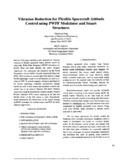Active Position Control of a Shape Memory Alloy Wire Actuated Composite Beam
| dc.contributor.author | Song, G. | |
| dc.contributor.author | Kelly, B. | |
| dc.contributor.author | Agrawal, B.N. | |
| dc.date.accessioned | 2013-07-18T19:18:28Z | |
| dc.date.available | 2013-07-18T19:18:28Z | |
| dc.date.issued | 2000 | |
| dc.identifier.citation | Journal of Smart Materials and Structures, Vol. 9, 2000, pp. 711-716. | |
| dc.identifier.uri | https://hdl.handle.net/10945/34542 | |
| dc.description | The article of record as published may be found at http://dx.doi.org/10.1088/0964-1726/9/5/316 | en_US |
| dc.description.abstract | This paper presents the design and the experimental result of the active position control of a shape memory alloy (SMA) wire actuated composite beam. The composite beam has a honeycomb structure with SMA wires embedded in one of its face sheets for the active actuation. The potential applications of this experiment include thermo-distortion compensation for precision space structure, stern shape control for submarines, and flap shape control for aeronautical applications. SMA wires are chosen as the actuating elements due to their high recovery stress (>500 MPa) and tolerance to high strain (up to 6%). However, SMA wires are inherently nonlinear and pose a challenge for control design. A robust controller is designed and implemented to actively control the tip position of the composite beam. The experiment set-up consists of the composite beam with embedded SMA wires, a programmable current/voltage amplifier to actuate the SMA wires, an infrared laser range sensor to detect the beam tip displacement, and a real-time data acquisition and control system. The experimental result demonstrates the effectiveness of the robust control.This paper presents the design and the experimental result of the active position control of a shape memory alloy (SMA) wire actuated composite beam. The composite beam has a honeycomb structure with SMA wires embedded in one of its face sheets for the active actuation. The potential applications of this experiment include thermo-distortion compensation for precision space structure, stern shape control for submarines, and flap shape control for aeronautical applications. SMA wires are chosen as the actuating elements due to their high recovery stress (>500 MPa) and tolerance to high strain (up to 6%). However, SMA wires are inherently nonlinear and pose a challenge for control design. A robust controller is designed and implemented to actively control the tip position of the composite beam. The experiment set-up consists of the composite beam with embedded SMA wires, a programmable current/voltage amplifier to actuate the SMA wires, an infrared laser range sensor to detect the beam tip displacement, and a real-time data acquisition and control system. The experimental result demonstrates the effectiveness of the robust control.This paper presents the design and the experimental result of the active position control of a shape memory alloy (SMA) wire actuated composite beam. The composite beam has a honeycomb structure with SMA wires embedded in one of its face sheets for the active actuation. The potential applications of this experiment include thermo-distortion compensation for precision space structure, stern shape control for submarines, and flap shape control for aeronautical applications. SMA wires are chosen as the actuating elements due to their high recovery stress (>500 MPa) and tolerance to high strain (up to 6%). However, SMA wires are inherently nonlinear and pose a challenge for control design. A robust controller is designed and implemented to actively control the tip position of the composite beam. The experiment set-up consists of the composite beam with embedded SMA wires, a programmable current/voltage amplifier to actuate the SMA wires, an infrared laser range sensor to detect the beam tip displacement, and a real-time data acquisition and control system. The experimental result demonstrates the effectiveness of the robust control.This paper presents the design and the experimental result of the active position control of a shape memory alloy (SMA) wire actuated composite beam. The composite beam has a honeycomb structure with SMA wires embedded in one of its face sheets for the active actuation. The potential applications of this experiment include thermo-distortion compensation for precision space structure, stern shape control for submarines, and flap shape control for aeronautical applications. SMA wires are chosen as the actuating elements due to their high recovery stress (>500 MPa) and tolerance to high strain (up to 6%). However, SMA wires are inherently nonlinear and pose a challenge for control design. A robust controller is designed and implemented to actively control the tip position of the composite beam. The experiment set-up consists of the composite beam with embedded SMA wires, a programmable current/voltage amplifier to actuate the SMA wires, an infrared laser range sensor to detect the beam tip displacement, and a real-time data acquisition and control system. The experimental result demonstrates the effectiveness of the robust control. | en_US |
| dc.rights | This publication is a work of the U.S. Government as defined in Title 17, United States Code, Section 101. As such, it is in the public domain, and under the provisions of Title 17, United States Code, Section 105, is not copyrighted in the U.S. | en_US |
| dc.title | Active Position Control of a Shape Memory Alloy Wire Actuated Composite Beam | en_US |
| dc.contributor.department | Department of Mechanical and Aerospace Engineering |





